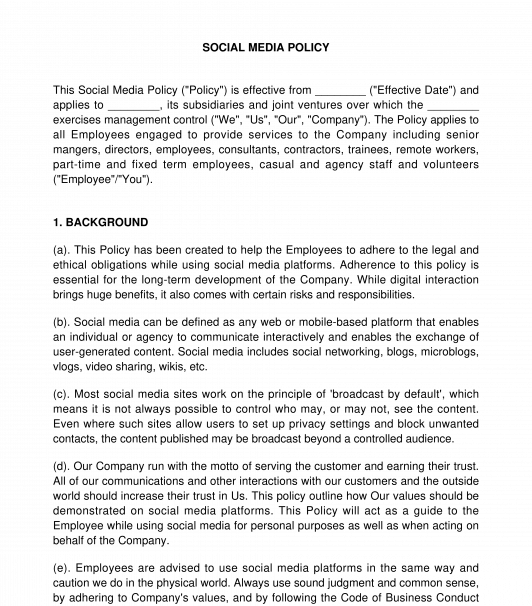 18-01-2025
18-01-2025

Answer a few questions and your document is created automatically.

Your document is ready! You will receive it in Word and PDF formats. You will be able to modify it.

 18-01-2025
18-01-2025
 Word and PDF
Word and PDF
 6 to 9 pages
6 to 9 pages
A Social Media Policy is a document used to advise the representative of an organization about their use of social media. With the rapid increase in the use of social media sites, it is pertinent to have a well-drafted policy to guide the representative about the proper uses and restrictions.
Having a social media policy for a business is essential in making sure the employees know what they should and should not do on social media channels. Additionally, it helps the organization to protect against any legal or security issues. Adherence to a properly drafted social media policy will also help the organization to protect its reputation, goodwill, and increase employee advocacy.
This Policy is a one-sided agreement drafted by the organization without any negotiation with the employees, and employees will have only the option to sign and acknowledge the same.
This policy can be used by any type of organization despite their size or type of business and can be used as a supplementary document to Employment Agreement, Employee Code of Conduct Policy, Non-Compete Agreement, Remote Work Policy, and Employee Privacy Policy.
How to use this document?
The policy covers the following important areas:
Once the policy is drafted, it can be circulated to the employees through electronic medium or in physical copies. The organization may ask the employees to acknowledge this policy and send it back for record purposes.
It is always better to make the policy accessible to all employees of the organization and update them whenever there are any changes made to this policy.
Applicable laws
The social media dealing will be covered under the Information Act of 2000 and rules enacted thereunder.
How to modify the template?
You fill out a form. The document is created before your eyes as you respond to the questions.
At the end, you receive it in Word and PDF formats. You can modify it and reuse it.
A guide to help you: Which Policies an Employer Needs to Implement at the Workplace?
Social Media Policy - Sample, template - Word & PDF
Country: India